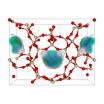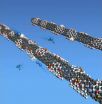(Press-News.org) Scientists have developed an ultra-sensitive test that should enable them to detect signs of a disease in its earliest stages, in research published today in the journal Nature Materials.
The scientists, from Imperial College London and the University of Vigo, have created a test to detect particular molecules that indicate the presence of disease, even when these are in very low concentrations. There are already tests available for some diseases that look for such biomarkers using biological sensors or 'biosensors'. However, existing biosensors become less sensitive and predictable at detecting biomarkers when they are in very low concentrations, as occurs when a disease is in its early stages.
In today's study, the researchers demonstrated that the new biosensor test can find a biomarker associated with prostate cancer, called Prostate Specific Antigen (PSA). However, the team say that the biosensor can be easily reconfigured to test for other diseases or viruses where the related biomarker is known.
Professor Molly Stevens, senior author of the study from the Departments of Materials and Bioengineering at Imperial College London, said:
"It is vital to detect diseases at an early stage if we want people to have the best possible outcomes - diseases are usually easier to treat at this stage, and early diagnosis can give us the chance to halt a disease before symptoms worsen. However, for many diseases, using current technology to look for early signs of disease can be like finding the proverbial needle in a haystack. Our new test can actually find that needle. We only looked at the biomarker for one disease in this study, but we're confident that the test can be adapted to identify many other diseases at an early stage."
The team demonstrated the effectiveness of their biosensor by testing PSA biomarker samples in solutions containing a complex mixture of blood derived serum proteins. Monitoring the levels of PSA at ultralow concentrations can be crucial in the early diagnosis of the reoccurrence of prostate cancer, but classic detection approaches are not sensitive enough to carry out this analysis with a high degree of accuracy. The new test could enable more reliable diagnosis, but more research will need to be done to further explore its potential.
In their study, the team detected PSA at 0.000000000000000001 grams per millilitre, which is at the limits of current biosensor performance. By comparison, an existing test called an Enzyme-Linked Immunosorbent Assay (ELISA) test can detect PSA at 0.000000001 grams per millilitre, which is nine orders of magnitude more concentrated.
The biosensors used in today's study consist of nanoscopic-sized gold stars floating in a solution containing other blood derived proteins. Attached to the surface of these gold stars are antibodies, which latch onto PSA when they detect it in a sample. A secondary antibody, which has an enzyme called glucose oxidase attached to it, recognises the PSA and creates a distinctive silver crystal coating on the gold stars, which is more apparent when the PSA biomarkers are in low concentrations. This silver coating acts like a signal that PSA is present, and it can be easily detected by scientists using optical microscopes.
The next stage of the research will see the team carrying out further clinical testing to assess the efficacy of the biosensor in detecting a range of different biomarkers associated with conditions such as HIV and other infections. They will also explore ways of commercialising their product.
###
This research was funded by the European Research Council and via a Marie Curie fellowship.
For further information please contact:
Colin Smith
Senior Research Media Officer
Imperial College London
Email: cd.smith@imperial.ac.uk
Tel: +44(0)20 7594 6712
Out of hours duty press officer: +44(0)7803 886 248
Laura Rodriguez-Lorenzo (2), Roberto de la Rica (1), Ramon Alvarez-Puebla (2), Luis M. Liz-Marzan (2), Molly Stevens (1)
(1) Department of Materials, Department of Bioengineering and Institute of Biomedical Engineering, Imperial College London, Exhibition Road London SW7 2AZ (UK)
(2) Departmento de Quimica Fisca, Universidade de Vigo, 36310, Vigo Spain
About Imperial College London
Consistently rated amongst the world's best universities, Imperial College London is a science-based institution with a reputation for excellence in teaching and research that attracts 14,000 students and 6,000 staff of the highest international quality. Innovative research at the College explores the interface between science, medicine, engineering and business, delivering practical solutions that improve quality of life and the environment - underpinned by a dynamic enterprise culture.
Since its foundation in 1907, Imperial's contributions to society have included the discovery of penicillin, the development of holography and the foundations of fibre optics. This commitment to the application of research for the benefit of all continues today, with current focuses including interdisciplinary collaborations to improve global health, tackle climate change, develop sustainable sources of energy and address security challenges.
In 2007, Imperial College London and Imperial College Healthcare NHS Trust formed the UK's first Academic Health Science Centre. This unique partnership aims to improve the quality of life of patients and populations by taking new discoveries and translating them into new therapies as quickly as possible.
Website: www.imperial.ac.uk
The Caterpillar got down off the mushroom and crawled away in the grass, remarking as it went, 'One side will make you grow taller, and the other side will make you grow shorter.'
-Alice's Adventures in Wonderland, by Lewis Carroll
UCLA geneticists have identified the mutation responsible for IMAGe syndrome, a rare disorder that stunts infants' growth. The twist? The mutation occurs on the same gene that causes Beckwith-Wiedemann syndrome, which makes cells grow too fast, leading to very large children.
Published in the May 27 edition of Nature Genetics, the UCLA ...
It took some 10 million years for Earth to recover from the greatest mass extinction of all time, latest research has revealed.
Life was nearly wiped out 250 million years ago, with only 10 per cent of plants and animals surviving. It is currently much debated how life recovered from this cataclysm, whether quickly or slowly.
Recent evidence for a rapid bounce-back is evaluated in a new review article by Dr Zhong-Qiang Chen, from the China University of Geosciences in Wuhan, and Professor Michael Benton from the University of Bristol. They find that recovery from the ...
Danang has a growing range of tourist facilities which is contributing to the growth of Danang as a tourism hub. To capitalize on this trend, Luxury Travel Ltd (www.luxurytravelvietnam.com). has just opened a new Danang office to meet increased luxury tour. Luxury Travel Ltd is a long established Asian specialist in the art of travel and serves today's most sophisticated travelers, in luxury privately guided and fully bespoke holidays in Vietnam, Laos, Cambodia, Myanmar and Thailand.
Danang has stepped into the tourism limelight as a much sought after destination for ...
Are members of the public divided about climate change because they don't understand the science behind it? If Americans knew more basic science and were more proficient in technical reasoning, would public consensus match scientific consensus?
A study published today online in the journal Nature Climate Change suggests that the answer to both questions is no. Indeed, as members of the public become more science literate and numerate, the study found, individuals belonging to opposing cultural groups become even more divided on the risks that climate change poses.
Funded ...
One of the UKs leading job sites, www.reed.co.uk, is supporting the '4G Britain' campaign encouraging the government to invest in 4G services, pointing out that the new technology could create thousands of jobs in the UK.
The job site is advocating a recent report published by Everything Everywhere, the UKs largest network operator, which suggests 125,000 jobs could be created with sufficient investment in 4G mobile data services.
Everything Everywhere, the company formed after the merging of Orange and T-Mobile phone networks, have been strong proponents of the ...
When power plants begin capturing their carbon emissions to reduce greenhouse gases – and to most in the electric power industry, it's a question of when, not if – it will be an expensive undertaking.
Current technologies would use about one-third of the energy generated by the plants – what's called "parasitic energy" – and, as a result, substantially drive up the price of electricity.
But a new computer model developed by University of California, Berkeley, chemists shows that less expensive technologies are on the horizon. They will use new solid materials like ...
"Life is full of moments when a need for financial help arises unexpectedly. Some of those moments are not easy by any means. A few weeks ago my grandmother passed away, and, with the void of losing a loved one, came the responsibility of making all the final arrangements for her, in Texas," said Mr. Reynolds.
"We needed to have all funeral expenses covered fast, but it was not very easy for my family financially. After doing my fair share of research online, PawnUp.com looked like the most obvious choice to help us with the money ASAP, and definitely ...
PHILADELPHIA — By pairing an intimate knowledge of immune-system function with a deep understanding of statistical physics, a cross-disciplinary team at the University of Pennsylvania has arrived at a surprising finding: T cells use a movement strategy to track down parasites that is similar to strategies that predators such as monkeys, sharks and blue-fin tuna use to hunt their prey.
With this new insight into immune-cell movement patterns, scientists will be able to create more accurate models of immune-system function, which may, in turn, inform novel approaches ...
Multi-walled carbon nanotubes riddled with defects and impurities on the outside could replace some of the expensive platinum catalysts used in fuel cells and metal-air batteries, according to scientists at Stanford University. Their findings are published in the May 27 online edition of the journal Nature Nanotechnology.
"Platinum is very expensive and thus impractical for large-scale commercialization," said Hongjie Dai, a professor of chemistry at Stanford and co-author of the study. "Developing a low-cost alternative has been a major research goal for several decades."
Over ...
At first glance, it's hard to see how a common house sparrow and a Tyrannosaurus Rex might have anything in common. After all, one is a bird that weighs less than an ounce, and the other is a dinosaur that was the size of a school bus and tipped the scales at more than eight tons.
For all their differences, though, scientists now say that two are more closely related than many believed. A new study, led by Harvard scientists, has shown that modern birds are, essentially, living dinosaurs, with skulls that are remarkably similar to those of their juvenile ancestors.
As ...


